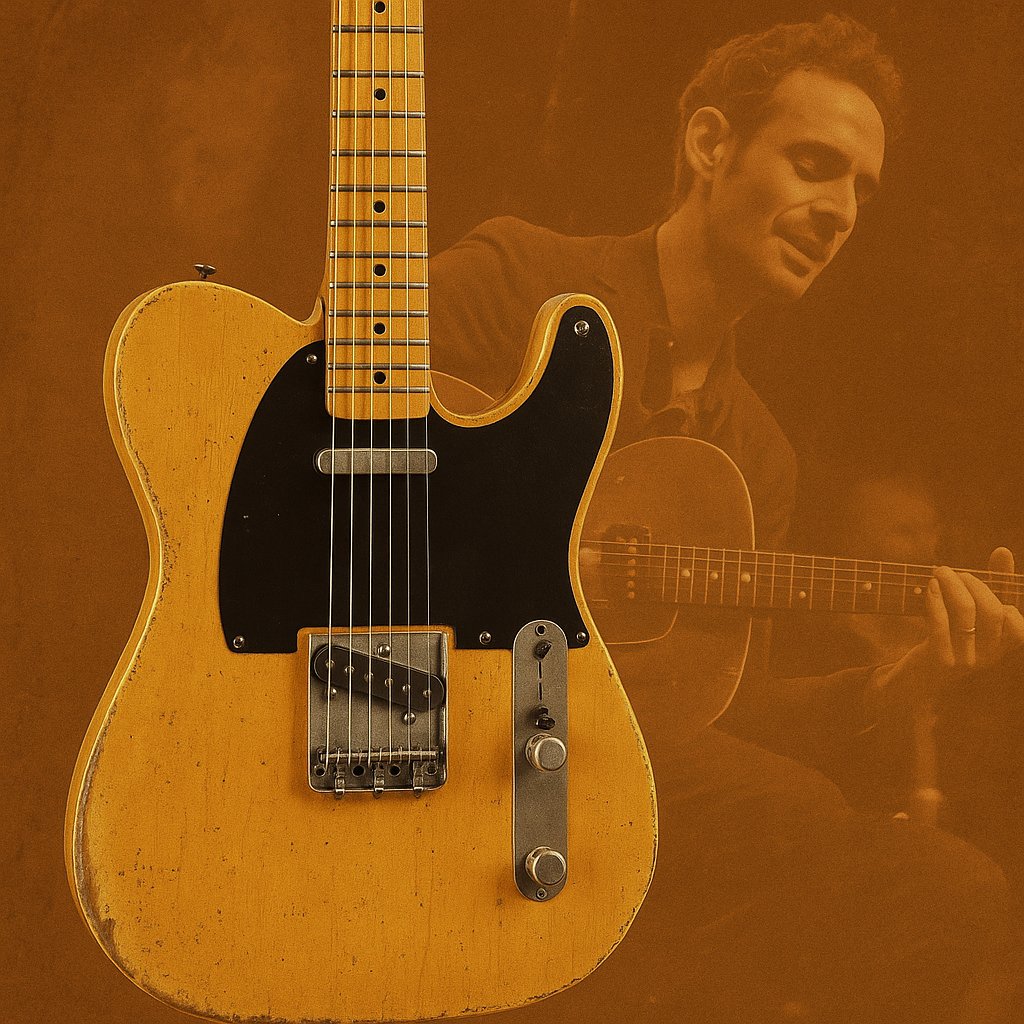There’s something almost mythical in the world of boutique guitar building when a name becomes synonymous with recreating lost treasures. Nacho Guitars (or “Nachoguitars”) is one such name. Founded by Spanish luthier Ignacio “Nacho” Baños, the brand is best known for its obsessively detailed tributes to early 1950s Fender instruments and, more recently, expansions into Gibson‑style territory.
In this post, we’ll explore:
-
The philosophy and approach behind Nacho Guitars
-
Reference models and signature lines (the “Nachocaster”, “Nachoburst”, Proto models, etc.)
-
Some of the more famous players who have adopted Nacho instruments
-
What makes them special (and what trade‑offs to be aware of)
1. Philosophy, Craft & Aesthetic
A. Historical Obsession & Reference Models
One of the core pillars of Nacho’s approach is using original vintage instruments as reference models. Rather than “random relicing,” Baños studies real scars, wear patterns, and construction idiosyncrasies to reproduce them faithfully.
He is widely regarded as one of the foremost experts in early Fender Telecasters (and their precursors) — so much so that his book The Blackguard (a multi‑hundred‑page compendium of early Teles) is often treated as bible among vintage enthusiasts.
In interviews, Nacho states his fascination is with the feel as much as the visual — how aged lacquer “breathes,” how the neck edges have been smoothed over decades, how hardware corrodes over time.
B. Materials, Aging & “Relic” Work
To maintain authenticity, materials are chosen to approximate vintage specs (ash bodies, maple necks, vintage‑style hardware, nitro lacquer).
The aging (or “relicing”) is not random: the wear is patterned to mirror real vintage wear, rather than generic “road wear.”
He also offers (or has offered) models with or without truss rods, hollow or solid bodies, contour shapes, “blackguard” vs “whiteguard” styles, etc.
One recent offering is a snake‑head Proto line, featuring 5” thick ash bodies, optional dual pickups, vertical or standard control routing, and 3-on-a-side “snake-head” tuning‑peg layouts.
2. Nacho Models & Lines
Below is a breakdown of some of the more prominent or talked‑about Nacho guitars:
|
Model / Line |
Description / Purpose |
Notable Features / Specs |
|---|---|---|
|
Nachocaster / Nacho “Tele” replicas |
This is the heart of Nacho’s reputation. Faithful recreations of early 1950s Fender Teles, especially the “Blackguard” era. |
Ash bodies, vintage hardware, correct bridge design, proper aging, early pickup windings. |
|
Contemporary “Blackguard / Whiteguard / Contour” variants |
Variations in body shape, guard layout, finish color, etc. |
Solid bodies, hollow options, with and without truss rods. |
|
Nachoburst |
Nacho’s expansion into the world of Gibson / Les Paul style instruments, with the same obsessive approach. |
Cherry sunburst nitro finishes, custom humbuckers, Maharogany + maple construction. |
|
Proto (Snake‑Head) |
As mentioned earlier, a more experimental line combining vintage cues with aesthetic deviations (snake-head tuners) and routing options. |
One example listing for a Nachocaster “1952 Telecaster style replica (relied heavily on reference originals)” describes early ‘50s style hardware, aged butterscotch finish, and even a humbucking mode in the middle position.
Another listing describes a 2020 Nachocaster built as a “relic replica of an original ‘Blackguard’ Telecaster” with early‑style hardware and aged finish.
A 2023 model spec sheet shows a “2023 Nachoguitars Blackguard” with body date 10/30/50, neck date 12/6/52, early style “bridge with compensated brass saddles,” and heavy relicing.
3. Famous Players & Users
One of the best ways to validate boutique instruments is to see which professional musicians adopt them. Nacho Guitars have attracted a number of serious players, especially among jazz, roots, and tone-focused guitarists.
Here are a few worth noting:
-
Julian Lage
Possibly the most prominent advocate. Lage’s go‑to Tele-style guitar is a Nachoguitars 1657 “Nachocaster”, outfitted with a P‑90 style neck pickup (Ellisonic) and a Blackguard‑style bridge pickup. He often sticks to neck pickup in performance.
Lage has expressed that the guitar gives him an “honest tone” with minimal fuss in his rig.
His album Speak to Me credits much of his clean electric work to that Nachocaster.
-
Bill Frisell
There are reports that Frisell plays a Nachocaster. A post on The Gear Page notes that his sound engineer confirmed his use of one.
-
Other names documented by Nacho’s workshop
In Nachoguitars’ promotional materials / PDF, they list players such as Redd Volkaert, Jeff Tweedy, Julian Lage, Arlen Roth, Ryan Wariner, and others.
-
John Scofield
In guitar‑forum chatter, Scofield is occasionally cited among “recent owners” of Nachocasters. (These are anecdotal, but reflect user communities’ awareness).
These endorsements suggest Nacho’s guitars are not just museum curiosities but instruments people can and will put into serious work.
4. What Makes a Nacho Guitar Special (Pros & Considerations)
Pros / Strengths
-
Attention to Detail / Authenticity — The level of reference-based relicing, wear, and aging is rare even in boutique instrument circles. Many builders use generic relic templates; Nacho attempts to mirror real life.
-
Tone & Feel Intent — Because the parts (wood, hardware, pickups) are selected to vintage spec, the aim is not just look but tonal integrity.
-
Customization — Buyers can often choose neck profile, finish level, pickup spec, serial number, etc.
-
Exclusivity / Artistic Value — These guitars are effectively art pieces with small runs, intentional relicing, and a story behind their craftsmanship.
Considerations / Trade‑offs
-
Cost & Rarity — These are high‑end boutique instruments, sometimes with long lead times, and limited availability.
-
Relic vs. “New Wear” Sensitivity — Some players prefer pristine finishes; others balk at relicing because it limits future clean restorations.
-
Support & Repairs — Because many parts are custom (aged, hardware, pickups), servicing abroad may require more effort.
-
Subjectivity of Replica Tone — Even with best efforts, no replica can perfectly mimic all the aged wood, subtle warps, and decades of playing found in true vintage instruments. Some players compare them more to “idealized vintage” than real vintage.
-
Community Expectations — Among vintage purists, replicas are often scrutinised under a high bar. Owners may face skepticism from collectors.
Conclusion
For guitarists who live for tone, nuance, and vintage soul — but want a reliably playable instrument — Nacho Guitars offer a rare blend of scholarship and luthiery. They are not for everyone (nor should they be), but for those seeking a deep connection to the golden era of electric guitars, a Nacho instrument can feel like touching a dream.









